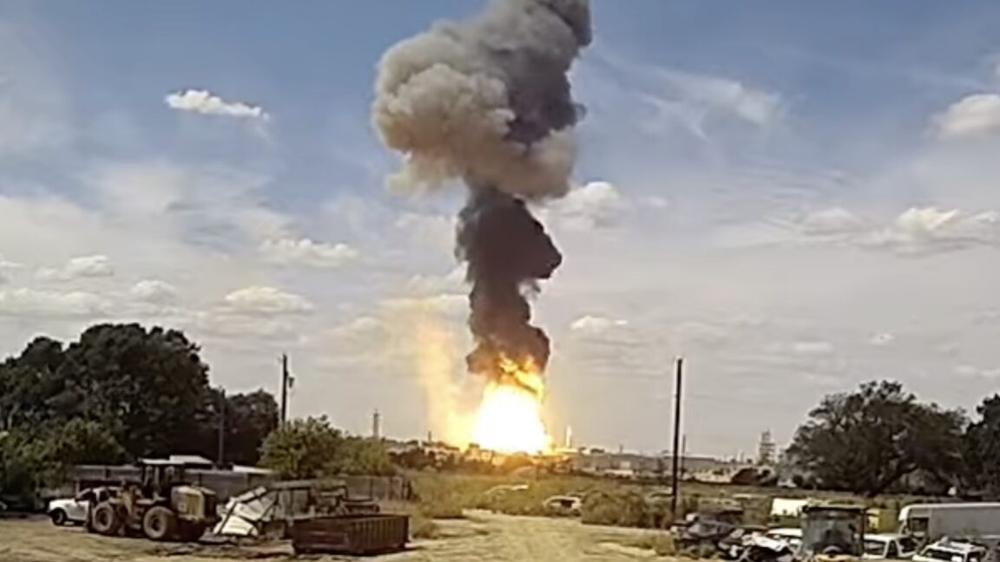The booster stage for Firefly Aerospace's next Alpha rocket was destroyed Monday in a fiery accident on the company's vertical test stand in Central Texas.
Engineers were testing the rocket before shipment to Vandenberg Space Force Base, California, to prepare for launch later this year with a small commercial satellite for Lockheed Martin. Activities at the vertical test stand in Briggs, Texas, include propellant loading and test-firings of the booster's four kerosene-fueled engines. The rocket was undergoing one of these test-firings on Monday when the accident occurred.
Firefly released a statement confirming the rocket "experienced an event that resulted in a loss of the stage." The company confirmed all personnel were safe and said ground teams followed "proper safety protocols."
These protocols include the immediate evacuation of the area around the test stand. For a typical test-firing at Briggs, Firefly engineers monitor activities from a control center inside a building about a quarter-mile away from the rocket. Firefly said it is assessing the condition of the test stand, and no other facilities were impacted.
Imagery posted on social media platforms showed a fireball engulfing the test stand and a column of black smoke rising into the sky over Firefly's facility roughly 40 miles north of Austin. A source told Ars that the fire appeared to have started inside the booster's engine bay.
"Regular testing is part of Firefly’s philosophy," the company said in a statement. "We test each critical component, engine, and vehicle stage to ensure it operates within our flight requirements before we ship to the launch pad. We learn from each test to improve our designs and build a more reliable system. We will share more information on the path forward at a later date."
Alpha’s track record
The booster destroyed Monday was slated to fly on the seventh launch of Firefly's Alpha rocket, an expendable, two-stage launch vehicle capable of placing a payload of a little over 2,200 pounds, or a metric ton, into low-Earth orbit.
This upcoming launch was supposed to be the Alpha rocket's return to flight after an in-flight failure in April, when the upper stage's engine shut down before the rocket could reach orbit and deploy its satellite payload.
But engineers traced the cause of the failure to the first stage, which ruptured milliseconds after stage separation, sending out a blast wave that damaged the upper stage engine. Investigators concluded the most likely cause of the rupture was thermal damage from a phenomenon known as plume-induced flow separation. This occurs when a rocket plume expands at higher altitudes, creating conditions that, in some cases, can draw the hot exhaust plume farther up the vehicle.
The Alpha rocket flew a higher angle of attack on the April launch than it did on prior missions, exposing one side of the rocket to more heating from the recirculated engine exhaust plume. At stage separation, the thermal damage led to the booster's structural failure. Firefly said it would add a thicker thermal protection barrier to the booster for future missions and reduce the angle of attack during key phases of flight.
Firefly announced last month that it received clearance from the Federal Aviation Administration to resume Alpha launches.
The rocket already had a mixed record heading into this year. Firefly has only achieved two fully successful missions in six launches of the Alpha rocket. Two missions put their payloads into off-target orbits, and two Alpha launches—the rocket's debut in 2021 and the flight in April—failed to reach orbit at all.
The accident Monday wasn't the first time Firefly encountered a fire on the test stand. An Alpha booster caught fire on the same test stand in 2020 during the lead-up to the rocket's inaugural flight, but officials extinguished the fire before it caused any major damage.
Firefly went public on the NASDAQ stock exchange last month, raising nearly $900 million in the initial public offering to help fund the company's future programs, namely the medium-lift Eclipse rocket developed in partnership with Northrop Grumman. The Eclipse rocket will use new, more powerful engines built by Firefly.
The company's other claim to fame is its Blue Ghost lunar lander program, which achieved the first fully successful landing of a commercial spacecraft on the Moon in March. NASA has selected Firefly for three more commercial landings on the Moon, and Firefly reported last week that it has an agreement with an unnamed commercial customer for an additional dedicated lunar mission.
However, the Alpha rocket, Firefly's original product, is struggling. Earlier this month, Firefly's rocket engines were the subject of ridicule from the CEO of Astra, a competitor and former partner.
There's some demand for a rocket like Alpha, which is larger than micro-launchers like Rocket Lab's Electron and smaller than SpaceX's Falcon 9. Lockheed Martin announced last year that it signed an agreement to purchase up to 25 Alpha launches from Firefly. The US Space Force, NASA, and National Oceanic and Atmospheric Administration are also booked to fly national security and weather satellites on future Alpha missions.

 The Best Time to Buy 4K and Blu-ray Movies at a Discount Every Year
The Best Time to Buy 4K and Blu-ray Movies at a Discount Every Year